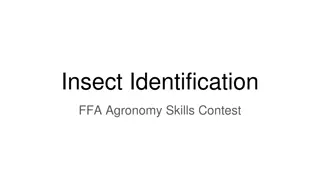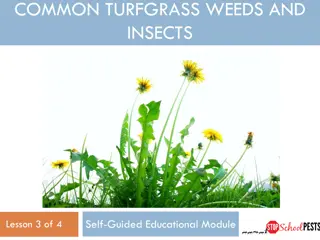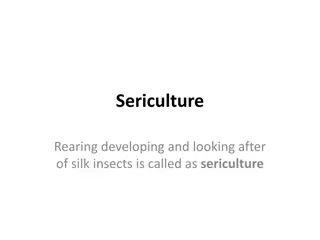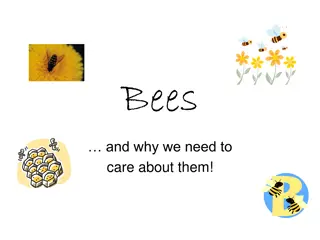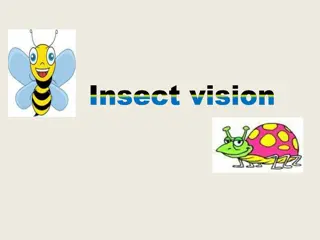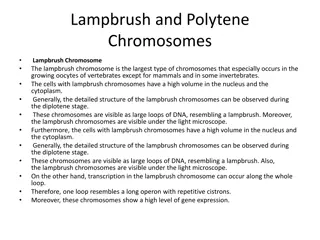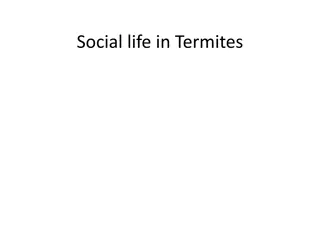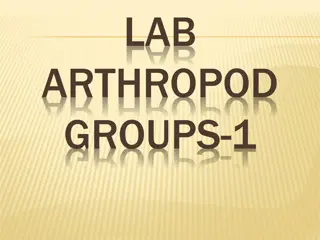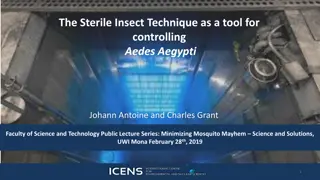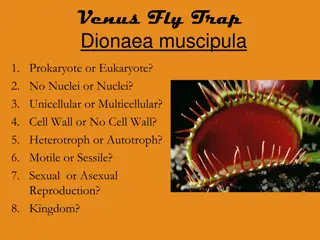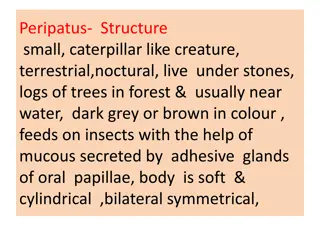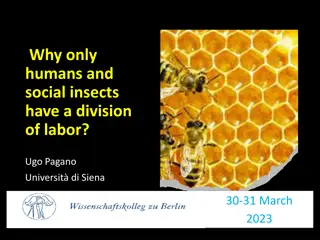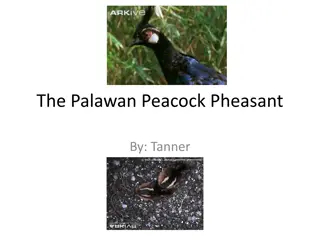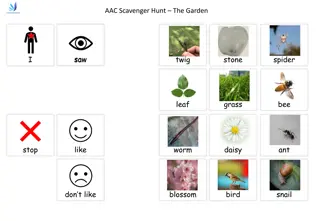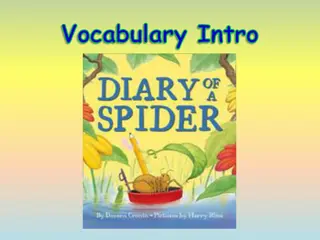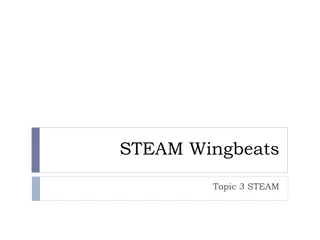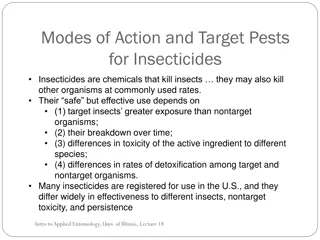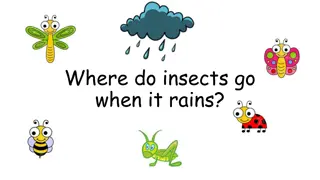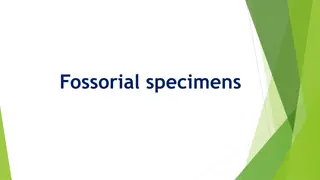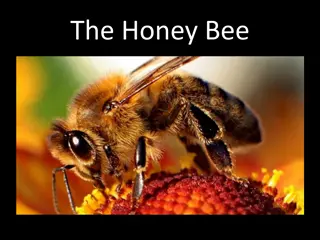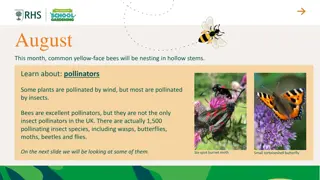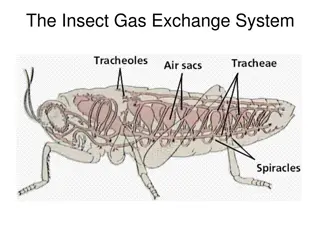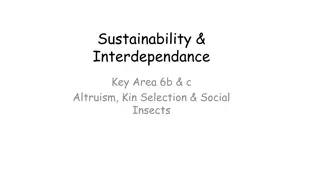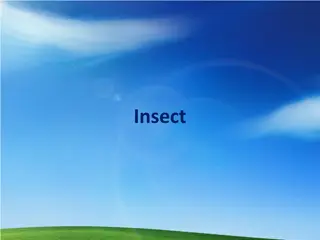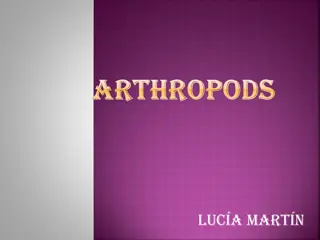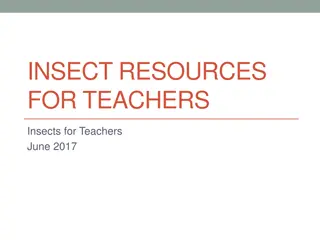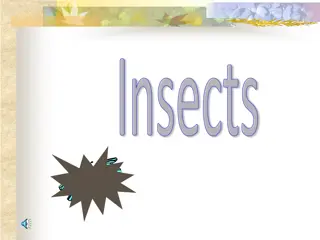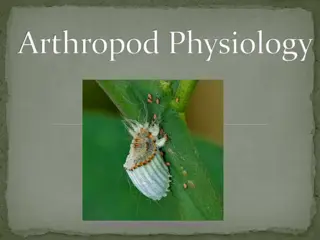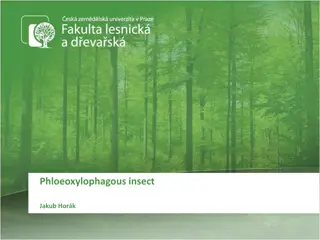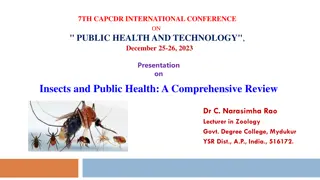Insect Abdominal Structures and Appendages: An Overview
The abdomen of insects plays crucial roles in respiration, reproduction, digestion, excretion, and metabolism. The number of abdominal segments varies across species, with reductions and modifications seen in different insect groups. From the propodeum to pregential and postgenital segments, each pa
3 views • 6 slides
Insect Identification for FFA Agronomy Skills Contest
Explore a variety of insects including the Alfalfa Weevil, Aphid, Army Worm, Assassin Bug, Bean Leaf Beetle, Black Cutworm, Chinch Bug, Colorado Potato Beetle, Common Stalk Borer, Corn Earworm, Corn Rootworm, Cricket, Cucumber Beetle, European Corn Borer, Flea Beetle, Grasshopper, Green Lacewing, Gr
1 views • 37 slides
ATH Export House
Athexporthouse.com is a renowned manufacturer of high-quality Gurjan face veneer in Indonesia. They use only the best quality Gurjan logs to produce veneers that are strong, durable, and resistant to moisture and insects. The veneers are carefully processed and graded to ensure consistency and unifo
0 views • 1 slides
Turfgrass Management Education: Weeds, Insects, and IPM
Explore the essential aspects of managing common turfgrass weeds and insects, along with adopting Integrated Pest Management (IPM) practices for maintaining healthy outdoor areas. Learn about plant species suited for specific environments, strategies to manage pests, and the components of an effecti
0 views • 41 slides
The Fascinating World of Sericulture: Rearing and Harvesting Silk Insects
Sericulture, the art of rearing and nurturing silk insects, has been practiced since ancient times, yielding the exquisite natural fiber known as silk. This fine material has captivated humans for its beauty and versatility. The process involves skill and scientific knowledge, with various types of
0 views • 16 slides
Importance of Bees: Why We Need to Care About Them
Bees are essential pollinators, with various species playing crucial roles in ecosystems. They forage for pollen and nectar, create honey, and live in diverse habitats. Bumble bees, honey bees, and solitary bees each have unique characteristics and contribute to biodiversity. However, bees face thre
6 views • 21 slides
Light Perception in Insects
Insects perceive light through various receptors such as compound eyes, ocelli, and stemmata. Compound eyes, made up of ommatidia, play a key role in capturing light stimuli ranging from UV to red wavelengths. Different types of compound eyes, like dioptric and holoptic, form images differently for
3 views • 12 slides
Lampbrush and Polytene Chromosomes: Structures and Functions
Lampbrush chromosomes, found in growing oocytes of vertebrates, display large loops of DNA during the diplotene stage, with high gene expression levels. Polytene chromosomes, giant interphase chromosomes in insects, contain multiple strands with distinct banding patterns. Chromocenter serves as the
0 views • 14 slides
Fascinating Insights into the Social Life of Termites
Termites, often referred to as white ants, are fascinating insects that play crucial roles in ecosystems. They are adept decomposers, benefiting agriculture by enriching soil. Termites live in large colonies led by a long-living queen, with distinct roles for different members such as workers and so
1 views • 8 slides
Overview of Arthropods: Classification and Characteristics
Arthropods are a diverse group of invertebrates characterized by segmented bodies, appendages, and chitinous exoskeletons. They belong to the Phylum Arthropoda and are classified into four important classes: Myriapoda, Crustacea, Arachnida, and Insecta. This article explores the unique features of e
0 views • 18 slides
The Buzz about Bees: Nature's Essential Pollinators
Bees play a crucial role in our ecosystem by pollinating plants and helping them multiply. There are various types of bees, each with unique characteristics. From the queen bee laying up to 2,000 eggs a day to the hive supporting up to 100,000 bees, these fascinating insects are vital for our enviro
0 views • 10 slides
Utilizing Sterile Insect Technique for Aedes Aegypti Control
The Sterile Insect Technique (SIT) is a biologically-based method used to manage key insect pests by releasing sterile insects to decrease population reproduction. This technique, developed through genetic manipulation and ionizing radiation, has been instrumental in controlling insect populations l
0 views • 13 slides
The Fascinating Venus Fly Trap - A Carnivorous Plant
The Venus Fly Trap, scientifically known as Dionaea muscipula, is a unique carnivorous plant found in the southern swamps of the US. It is a eukaryotic, multicellular autotroph that thrives in poor, nutrient-deficient soils by capturing insects for essential nutrients like nitrogen. Its trapping mec
0 views • 12 slides
Anatomy and Characteristics of Peripatus
Peripatus is a small, caterpillar-like terrestrial creature found in forests near water. It has dark grey or brown color, feeds on insects using mucous secreted by adhesive glands, and has a soft cylindrical body with bilateral symmetry. The body is divided into a head and trunk, with distinct featu
1 views • 27 slides
Evolution of Division of Labor in Humans and Social Insects
Evolutionary advantages of cooperation and specialization led to a developed system of social cooperation and division of labor in humans and social insects. Despite vast differences, these species have conquered the earth due to common characteristics. The puzzle lies in why only a few species evol
2 views • 23 slides
The Majestic Palawan Peacock Pheasant: A Detailed Overview
The Palawan Peacock Pheasant is a stunning bird species found on Palawan Island, Philippines. Known for its striking blue, black, and white coloration, this bird feeds on seeds, nuts, fruits, and insects. With males weighing around 21 oz and females around 18 oz, they also have distinct sizes. Unfor
0 views • 12 slides
Fascinating Facts About the Carolina Wolf Spider
The Carolina Wolf Spider, known for its gray and brown body with dark stripes, resides in South America in various habitats like woodlands and coastal forests. It feeds on insects like fruit flies and ants and defends itself via non-poisonous venom bites. Interestingly, this spider doesn't weave web
0 views • 11 slides
Garden Scavenger Hunt Adventures!
Join in the fun as you explore the garden with a scavenger hunt! Search for items like twigs, stones, insects, flowers, and more. Discover the wonders of nature as you spot various creatures and plants along the way. Let the adventure begin in this interactive outdoor activity that is both education
0 views • 8 slides
Discovering New Words and Concepts Through Images
Explore the world of vocabulary with engaging images and descriptions. Learn about insects, dangerous situations, sticky objects, and more. Dive into the meanings of words like "rotten," "judge," and "screaming" while expanding your language skills.
0 views • 9 slides
Fascinating Wingbeat Facts of Hummingbirds and More
Discover the mesmerizing world of wingbeats, from hummingbirds in the Americas to various birds and insects in the United States. Unveil the astounding capabilities of these creatures as they flutter their wings with remarkable speed and agility. Dive into research, calculations, and creative activi
0 views • 4 slides
Overview of Insecticides: Modes of Action, Target Pests, and Types
Insecticides are chemicals used to kill insects, but their effectiveness and safety depend on various factors like target specificity, breakdown over time, and toxicity differences. Different classes of insecticides such as Organochlorines, Organophosphates, Carbamates, Pyrethroids, and Neonicotinoi
0 views • 40 slides
Where Do Insects Go When It Rains?
Bees huddle together to stay warm, ladybugs hibernate in groups, butterflies hide under leaves or rocks, grasshoppers seek shelter in sheds, buildings, or crevices, and dragonflies brush off water and cling under vegetation when it rains.
3 views • 6 slides
Fossorial Specimens: Mole and Caecilian Adaptations
Fossorial specimens, including the mole and caecilian, are uniquely adapted for subterranean burrowing. The mole, commonly known for its wedge-shaped head and reduced eyes, lives in tunnels and feeds on small worms and insects. On the other hand, the limbless caecilian, resembling a worm, thrives in
2 views • 25 slides
Fascinating Facts About Honey Bees
Discover the incredible world of honey bees, including their three types or castes, body regions, unique features like compound and simple eyes, antennae, proboscis, and mandibles. Explore how their thorax enables flight with four wings, and learn about the speed and agility of these remarkable inse
0 views • 21 slides
The Antioxidant Properties of Honey Explored by Prof. Dr. Eitedal M. Daoud
Explore the fascinating world of honey and its multitude of benefits, from its antioxidant properties to its rich mineral content. Delve into the traditional knowledge of honey alongside modern scientific advancements in apitherapy. Discover how honey, a natural product derived from insects, has bee
0 views • 25 slides
Discovering Pollinating Insects in the UK
Learn about the diverse world of pollinating insects in the UK, including bees, moths, wasps, butterflies, beetles, and flies. Explore how these insects play a crucial role in pollination, benefiting plant ecosystems. Engage in a fun learning activity to spot different pollinators in the wild and un
1 views • 7 slides
Enlightening Future on Nutritional Values of Edible Insects for Health
Edible insects are a valuable protein source with potential health benefits and economic advantages. This research explores the nutritional value of edible insects, their role as an alternative food source, and their impact on human health. Findings highlight the importance of promoting the consumpt
0 views • 14 slides
The Insect Gas Exchange System
The insect gas exchange system involves spiracles, tracheae, and tracheoles that facilitate the exchange of gases to support respiration in insects. Spiracles lined with chitin control airflow, while tracheae and tracheoles enable oxygen to dissolve into the haemolymph through passive diffusion, sup
0 views • 18 slides
Altruism, Kin Selection, and Social Insects in Sustainability
Altruism, kin selection, and social insects play crucial roles in sustainability. Altruistic behavior, like reciprocal altruism and kin selection, benefits recipients while potentially harming donors. Social insects, such as bees and ants, exemplify cooperation and societal structures that aid in ec
0 views • 29 slides
Embracing Insect-Based Diets for a Sustainable Future
Emphasizing the urgency of meeting the growing protein demand sustainably, the article explores the benefits of entomophagy - consuming insects as food. Experts advocate for insect-based diets to address environmental concerns, citing insects as a rich protein source with lower greenhouse gas emissi
0 views • 6 slides
Insect Life Cycles and Management Strategies
Exploring the world of insects, this content delves into the life cycles and damage caused by key insect pest groups, emphasizing the importance of knowing their life stages for effective pest management. It covers insect development, how insects cause injury, pest control principles, threshold leve
0 views • 20 slides
The Abdomen in Insects
The abdomen in insects is a crucial body region composed of 11 segments, each with specific functions such as bearing external genitalia and ovipositors. It is divided into pregenital, genital, and postgenital segments, with appendages specialized for reproduction. The ovipositor, essential for egg-
0 views • 17 slides
Fascinating World of Arthropods: From Insects to Arachnids
Arthropods, the largest and most successful group in the animal kingdom, encompass a wide range of organisms, including insects, arachnids, myriapods, and crustaceans. Insects, with their distinct body regions and exoskeleton, play crucial roles in ecosystems. Arachnids, such as scorpions and spider
0 views • 14 slides
Comprehensive Insect Resources and Projects for Teachers
Explore a wealth of resources and successful classroom projects centered around insects, perfect for teachers looking to engage their students with hands-on learning experiences. Discover easy-to-keep insects, online tools for identification, and educational platforms like the NASA Butterfly Rearing
0 views • 5 slides
The Fascinating World of Insects and Animal Classification
Discover the unique characteristics of insects such as their body parts, legs, compound eyes, antenna, and exoskeleton. Learn about the classification of animals into insects and non-insects, as well as vertebrates and invertebrates. Explore how animals can be sorted based on different criteria and
0 views • 35 slides
Overview of Arthropod Physiology and Morphology
Explore the fascinating world of arthropods, focusing on their physiology and morphology. Discover the unique features of insects like their open circulatory system, complete digestive system, and dorsal brain. Delve into the specialized structures of Hemipteran insects such as their modified beaks
0 views • 11 slides
Phloeoxylophagous Insects and Their Impact on Forests
Phloeoxylophagous insects, such as bark and ambrosia beetles, play a significant role in forestry as wood-boring organisms. This group primarily consists of beetles, hymenopterans, and flies, with beetles being the most prevalent. The last generation of Ips typographus, a bark beetle, undergoes a cr
0 views • 55 slides
Insects and Public Health: A Comprehensive Review
Animalia kingdom has over 1.5 million species, with Arthropoda phylum dominating, mainly comprising insects. Insects play vital ecological roles but also spread diseases, costing billions annually and causing significant human deaths worldwide, especially through mosquito-borne diseases.
0 views • 15 slides
Harmful Insects
Harmful insects like mosquitoes and cockroaches pose health risks and nuisance. Mosquitoes transmit diseases including malaria and dengue fever, while cockroaches are common household pests. Learn about their habits, life history, damage caused, and control methods.
0 views • 20 slides
Captivating Images of Iguanas, Igloos, Insects, and More
Discover a stunning collection of images showcasing various subjects, including iguanas, igloos, insects, cozy interiors, tempting ice cream treats, and icy landscapes. Each image is meticulously curated and presented in high-quality resolution, offering a visual feast for the eyes. Explore the intr
0 views • 7 slides

